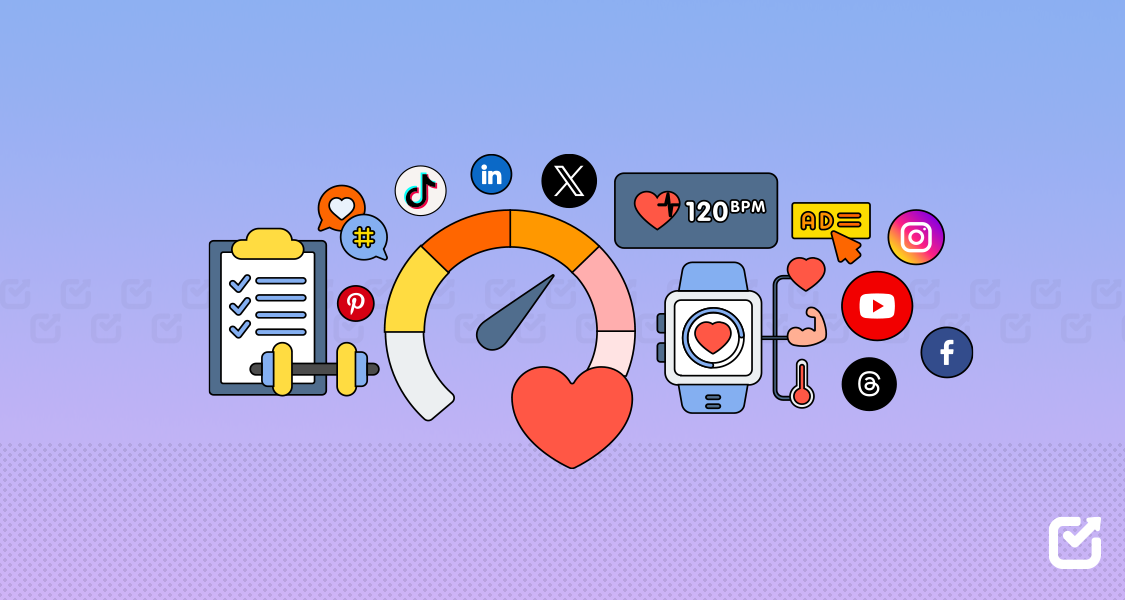Ever wonder why some tweets explode with engagement while others barely get a like?
It’s not luck, it’s the Twitter algorithm, and this year, it’s playing a whole new game.
The platform (still widely called Twitter, even if Elon insists on “X”) now uses a smarter, ML-driven system to decide what shows up in your feed.
That means every like, retweet, pause, or swipe tells the algorithm what you want more of and what to quietly bury.
If you want more engagement on this platform, you need to understand how it works.
However, you don’t need to be a tech expert to understand it. Once you know what the algorithm likes, you can start creating tweets that get seen by more people.
In this post, we’ll break down how the Twitter algorithm works, how an X scheduler can make the process easier, and easy tips to help you beat it.
Let’s get into it.
CTA
Ready to Boost Engagement Around the Clock?
Let Social Champ publish your tweets when your audience is most active. Start your free trial today.
Short Summary
- The Twitter algorithm uses machine learning to personalize feeds based on user behavior, engagement, and content relevance.
- Tweets are ranked and shown across three main sections: “For You,” “Following,” and “Explore,” each using different recommendation models.
- Key ranking signals include likes, retweets, replies, shares, impressions, and early engagement metrics.
- To perform well, content should be timely, interactive, and designed to engage both in-network and out-of-network audiences.
- Scheduling tools like Social Champ help optimize posting times, maintain consistency, and analyze tweet performance to align with the algorithm.
What Is the Twitter (X) Algorithm and Why Does It Matter
The Twitter algorithm (now powering what we see on X) is the system that decides which tweets appear on your timeline and in what order.
It’s responsible for sorting through millions of tweets every day and deciding which ones deserve a spot on your feed.
Instead of showing content in real time, Twitter uses a ranking system that prioritizes tweets based on relevance, not recency.
So, how does it decide? It looks at things like:
- Who do you interact with most
- What kind of content do you usually engage with
- How popular or active a tweet is
- When the tweet was posted
This matters a lot, especially if you’re trying to grow an audience.
Whether you’re a content creator, a business, or just someone who wants their tweets to be seen, the algorithm stands between your post and your potential reach.
Featured Article: The Ultimate SaaS Marketing Strategy for 2025: 15 Proven Tactics to Drive Growth
How the Twitter (X) Algorithm Works in 2025
Twitter has over 600 million users, but only a small fraction of posts reach a wide audience.
Today, this system has become more refined and user-centric.
It pulls from a huge pool of data, such as your likes, replies, follows, reading time, and even what similar users engage with, to decide what appears on your timeline.
Let’s see how the Twitter algorithm works in detail!
The Core of the Twitter Algorithm
At its heart, the Twitter algorithm is a recommendation engine. It works in three key steps:
- Sourcing: From both people you follow (in-network) and those you don’t (out-of-network).
- Ranking: It scores each tweet based on its relevance to you.
- Filtering: It removes tweets that may be repetitive, low quality, or irrelevant, giving you a cleaner, more engaging timeline.
The Three Main Twitter (X) Feeds and How They Work
X offers three main feeds: For You, Following, and Explore. Each uses the Twitter algorithm differently.
-
The “For You” Timeline
The “For You” feed is where Twitter’s algorithm shows its full capabilities.
It blends tweets from accounts you follow with algorithmically recommended posts from accounts you don’t.

Twitter For You Tab Here’s how it works:
- Candidate Sourcing: The algorithm pulls in tweets from both In-Network and Out-of-Network sources, based on your past behavior and interaction patterns.
- Engagement Prediction: Tweets are ranked based on how likely you are to engage with them.
- Continuous Learning: The more you interact with certain types of content, the more the algorithm adapts. It learns your preferences and fills your “For You” tab with tweets that fit your habits.
Notably, the latest update to the “For You” timeline emphasizes surfacing content from smaller or emerging accounts to democratize visibility and amplify diverse voices.
-
The “Following” Timeline
This tab offers a more familiar experience: tweets in mostly chronological order from accounts you follow.

Twitter Following Tab However, even here, the algorithm isn’t entirely absent:
- Chronological Baseline: Tweets are ordered by time of posting, giving users a real-time snapshot of what’s happening.
- Selective Boosting: High-engagement tweets (with many likes, retweets, or replies) may be subtly boosted even within this linear feed.
- No Out-of-Network Content: Unlike the “For You” feed, everything here comes only from accounts you follow, offering a cleaner, more predictable stream of content.
-
The “Explore” Tab
The “Explore” tab is designed for discovery.
It’s where Twitter surfaces trending content and breaking news from across the platform, grouped under categories such as News, Sports, and Entertainment.

Twitter Explore Tab - Trending Engine: The algorithm identifies spikes in activity around hashtags, keywords, and topics, then aggregates this content for the Explore page.
- Category-Based Personalization: Users can browse by category, and the algorithm adapts based on what they click and engage with over time.
- Global + Local Trends: It also customizes your experience based on geography and interests, helping you discover what’s relevant both locally and globally.
Top Twitter (X) Algorithm Ranking Signals to Know
The Twitter algorithm prioritizes content based on a wide range of ranking signals that reflect user behavior, content relevance, and engagement patterns.
Understanding these signals gives you the power to craft tweets that align with how the algorithm operates.
Here are the most important ranking signals currently shaping visibility and engagement on Twitter (X):
- Engagement
- Recency
- Relevance
- Account Credibility
- Media Usage
- User Feedback Signals
Engagement
Engagement remains a cornerstone of X’s ranking system.
The algorithm evaluates how users interact with tweets to assess their relevance and quality.
Key engagement metrics include:
- Likes: Indicate user approval and contribute to a tweet’s visibility.
- Retweets: Signal that users find the content shareworthy, extending its reach.
- Replies: Foster conversations and can significantly boost a tweet’s prominence.
- Shares (Quote Tweets): Allow users to add their commentary, further amplifying the tweet’s exposure.
Recency
Timeliness is crucial on X.
The algorithm prioritizes fresh content to keep users informed about the latest developments.
Recent tweets are more likely to appear in users’ feeds, especially if they align with current trends or breaking news.
Relevance
X’s algorithm strives to present users with content that aligns with their interests and past behaviors. It considers factors such as:
- User Interaction History: The more a user interacts with your content, the more likely your future tweets will appear in their feed.
- Content Similarity: Tweets that share themes or topics with content a user has previously engaged with are prioritized.
Account Credibility
The trustworthiness of your account plays a role in how your content is ranked.
Verified accounts or those with a strong reputation are often prioritized.
Regular posting and engagement signal to the algorithm that your account is active and reliable.
Media Usage
Incorporating rich media into your tweets can enhance their appeal and engagement.
Tweets containing images, videos, or GIFs tend to attract more attention and interaction.
The algorithm often boosts tweets that include visual content because they are more likely to catch people’s attention.
User Feedback Signals
The algorithm takes into account how users respond to your content beyond direct engagement.
If users mute, block, or report your content, it can negatively impact your tweet’s visibility.
Conversely, if users share your content, it indicates that it is resonating with a wider audience.
CTA:
Ready to Outplay the Algorithm?
Schedule tweets, track engagement, and boost visibility, all from one easy-to-use dashboard!
How to Optimize Your Tweets for the Twitter (X) Algorithm
If you’re trying to get more reach, likes, or retweets on X (formerly Twitter), understanding the Twitter algorithm is only half the battle.
The other half is knowing how to optimize your tweets to perform well within that system.
The Twitter algorithm is smarter and more selective, meaning you need to be intentional with what, when, and how you post.
Below are proven strategies that can help boost your visibility and engagement while working with the algorithm, not against it.
-
Post When Your Audience Is Most Active
Timing matters. Even with a personalized feed, tweets posted when your audience is online have a better chance of getting immediate engagement, which the algorithm loves.
Best Practices:
- Post during peak hours.
- Use X’s analytics to find when your followers are most active.
- Test on different days of the week. Tuesday through Thursday often see the most engagement.
-
Use Engaging, Clear Formats
The Twitter algorithm ranks content based on its ability to capture attention and drive interaction.
Using the right format increases the chances of your tweets being seen and shared.
Content formats that perform well:
- Text + Visual – Tweets with images, GIFs, or short videos tend to get up to 3x more engagement than text-only posts.
- Polls – Encourage interaction and are often prioritized in timelines.
- Threads – Great for storytelling or breaking down ideas. The first tweet should be strong enough to stand alone.
- Quote tweets – Boost visibility by creating a conversation around someone else’s content.
- Shorter tweets (under 280 characters) – These tweets still tend to perform best, but don’t be afraid to go longer if your content is valuable.

Snapshot of Text+Visual Tweet -
Spark Engagement
If you want to know how Twitter algorithm works, here’s the simple version: tweets that get fast, authentic engagement are rewarded with more visibility.
So, how do you get people to interact?
Try This:
- Ask a question at the end of your tweet to invite replies.
- Use humor or hot takes to get reactions and quote tweets.
- Tag relevant accounts when appropriate—but don’t spam.
-
Stay Consistent
The algorithm favors active and consistent accounts.
If you post once a week, you’re far less likely to show up in people’s feeds than someone posting regularly.
What to Do:
- Aim for at least 1–3 tweets per day.
- Schedule posts ahead of time using Social Champ.
Consistency also helps the algorithm understand what your account is “about,” which can lead to more accurate placements in user feeds.
-
Use Keywords and Hashtags Wisely
Using the right keywords can help X’s algorithm categorize your content better, improving its chances of appearing in the For You or Explore tabs.
Tips:
- Include niche-relevant keywords in your tweets and profile.
- Use 1–2 relevant hashtags (not 10!) to help with discoverability.
This not only helps users find your tweets but also teaches the algorithm what your content is about.

Snapshot of a Tweet With a Hashtag -
Interact Like a Real Human
The Twitter (X) algorithm explained in simple terms: it boosts accounts that contribute to conversation—not those that only broadcast.
Do This:
- Reply to other tweets daily.
- Retweet content with thoughtful comments.
- Thank people who engage with your posts.
- Join trending conversations (when relevant) using the Explore tab.

Snapshot of Interaction on Twitter -
Clean Up if Needed: How to Reset Twitter (X) Algorithm
Not getting the kind of content you want, or feel like the algorithm is showing you the wrong stuff?
Here’s how to reset the Twitter algorithm:
- Switch to the “Following” tab for a while to see content only from accounts you follow.
- Mute or unfollow accounts you’re no longer interested in.
- Clear your search history and stop interacting with irrelevant topics.
- Go to Settings > Privacy and safety > Content you see, and update your interests.
- Start interacting with the type of content you want to see more of.
These steps help “train” the algorithm to better match your preferences.
Featured Article: How to Schedule Bluesky Posts: Streamline Your Social Media Strategy
Scheduling Tweets With Social Champ to Maximize Reach
The Twitter algorithm rewards not just quality and engagement, but timing and consistency.
That’s where a smart scheduling tool like Social Champ becomes essential.
Social Champ is a full-fledged social media management platform designed to help you strategically align with the Twitter (X) algorithm.
With this tool, you can plan and schedule an entire week or month of content in advance.
Its built-in best time to post suggestions allow you to post when your followers are most likely to see and engage with your content.
You also gain clear insights into which types of tweets perform best, when they should be posted, and how you can tweak future posts to match what the algorithm favors.
CTA
Beat the Twitter Algorithm—Start Winning Today!
Social Champ makes it easier to grow your Twitter presence and dominate the FYP. Don’t wait—maximize your growth today!
Common Mistakes That Hurt Your Twitter (X) Algorithm Performance
To enhance your visibility on X (formerly Twitter), it’s crucial to avoid certain missteps that can hinder your algorithmic ranking.
-
Overusing Hashtags
Utilizing multiple hashtags can make your tweets appear spammy and may reduce their reach.
It’s advisable to limit hashtags to one or two relevant ones per tweet.
-
Ignoring Analytics
Failing to monitor your tweet performance means missing out on valuable insights.
Regularly reviewing analytics helps refine your content strategy for better engagement.
-
Posting Irregularly
Inconsistent posting can lead to decreased visibility.
Maintaining a regular posting schedule keeps your audience engaged and signals to the algorithm that you’re an active user.
-
Engaging Only With Small Accounts
Interacting predominantly with smaller accounts may limit your exposure.
Engaging with a mix of small, medium, and large accounts can broaden your reach.
-
Using External Links
Including external links in your tweets can decrease their reach, as X prefers to keep users on the platform.
If necessary, place links in replies rather than the main tweet.
Conclusion
The Twitter algorithm continues to evolve, and understanding how it works is key to boosting your content’s visibility and engagement.
From the importance of engagement metrics to the impact of timing and content relevance, every factor plays a role in how your tweets are ranked.
You can improve your chances of success by avoiding common mistakes, optimizing your posting schedule, and leveraging Social Champ.
Ultimately, staying informed about how the Twitter algorithm works and adjusting your strategies accordingly will help you thrive on the platform, reach a broader audience, and maximize engagement.
Frequently Answered Questions
1. How Does the Twitter (X) Algorithm Determine What I See?
2. What Factors Influence the Twitter (X) Algorithm?
3. How Can I Improve My Visibility on Twitter (X)?
4. Does the Twitter (X) Algorithm Favor Certain Types of Content?
5. What Is the Difference Between the “For You” and “Following” Feeds on Twitter (X)?
















